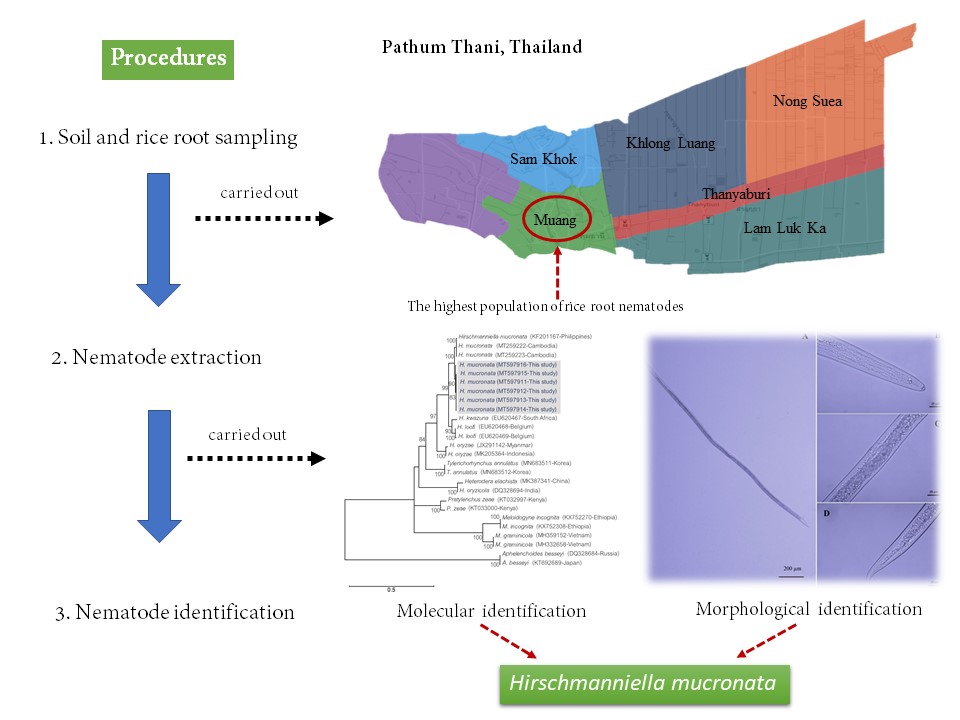Incidence and Characterization of Rice Root Nematodes, Hirschmanniella mucronata, from Rice Fields in Pathum Thani Province, Thailand
DOI:
https://doi.org/10.48048/tis.2021.486Keywords:
Nematode identification, Hirschmanniella mucronata, Rice cultivars, Pathum ThaniAbstract
The rice root nematodes, Hirschmanniella oryzae and H. mucronata, are serious and widespread threats to global rice production, especially in tropical and subtropical zones. Reliable and efficient identification of these nematodes is vital to nematode control and management. In this current study, 36 soil or rice root samples were collected from rice fields located in Pathum Thani province and used for nematode extraction. The results demonstrated that Hirschmanniella sp. was found in all paddy fields, especially in Muang District, where RD47 rice cultivars were grown at soil pH of 5.9. Molecular identification based on the analysis of 28S rRNA and 18S-ITS1-1.58S genes revealed 98 – 99 % similarity to H. mucronata, and its phylogenetic trees were grouped with H. mucronata from Cambodia and Philippines. Likewise, the morphometric characterization revealed remarkable features of H. mucronata with long body (1,639 - 2,329 µm), long stylet (24 - 27 µm) and an obvious mucron at the end of terminus. Therefore, the main rice root nematode species found in Pathum Thani’s rice fields were H. mucronata.
HIGHLIGHTS
- The rice root nematodes, Hirschmanniella, are presented the predominant plant-parasitic nematodes in rice cultivated areas of Pathum Thani province, Thailand
- Population densities of Hirschmanniella are encountered in rice roots than in soil, especially in RD47 rice cultivars grown in Muang District
- Both of morphological and molecular characterization illustrating the species of rice root nematodes were H. mucronata
- This is a first description on the molecular characterization of H. mucronata from rice fields in Thailand
GRAPHICAL ABSTRACT
Downloads
Metrics
References
Rice Department, Available at: http://brrd.ricethailand.go.th/ricemap/riceCD52/index.php-url=detail.php®ion_id=1&province_id=13.htm, accessed July 2020.
Office of Agricultural Economics, Available at: http://www.oae.go.th/assets/portals/1/fileups
/prcaidata/files/second%20rice%2062%20province%2030-1-63-2(2).pdf, accessed January 2020.
IJ Shelley, M Takahashi-Nosaka, M Kano-Nakata, MS Haque and Y Inukai. Rice cultivation in Bangladesh: present scenario, problems, and prospects. J. Int. Cooperat. Agr. Dev. 2016; 14, 20-9.
JT Jones, A Haegeman, EGJ Danchin, HS Gaur, J Helder, MGK Jones, T Kikuchi, R Manzanilla-Lopez, JE Palomares-Rius, WML Wesemael and RN Perry. Top 10 plant-parasitic nematodes in molecular plant pathology. Mol. Plant Pathol. 2013; 14, 946-61.
GC Bernard, M Egnin and C Bonsi. The impact of plant-parasitic nematodes on agriculture and methods of control. In: MM Shah and M Mohamood (Eds.). Nematology - concepts, diagnosis and control. InTech, London, 2017, p. 121-51.
ZTZ Maung, PP Kyi, YY Myint, T Lwin and D Waele. Occurrence of the rice root nematode Hirschmanniella oryzae on monsoon rice in Myanmar. Trop. Plant Pathol. 2010; 35, 3-10.
MMA Youssef and MFM Eissa. The rice root nematode, Hirschmanniella oryzae, its identification, economic importance and control measures in Egypt: A review. Arch. Phytopathol. Pflanzenschutz 2014; 47, 2340-51.
T Kyndt, D Fernandez and G Gheysen. Plant-parasitic nematode infections in rice: molecular and cellular insights. Annu. Rev. Phytopathol. 2014; 52, 135-53.
DY Chen, HF Ni, JH Yen, RS Chen and TT Tsay. Distribution of rice root nematode Hirschmanniella oryzae and a new recorded H. mucronata (Nematoda: Pratylenchidae) in Taiwan. Plant Pathol. Bull. 2006; 15, 197-210.
MLD Pascual, W Decraemer, I Tandingan De Ley, A Vierstraete, H Steel and W Bert. Prevalence and characterization of plant-parasitic nematodes in lowland and upland rice agro-ecosystems in Luzon, Philippines. Nematropica 2014; 44, 166-80.
K Khun, W Decraemer, M Couvreur, G Karssen, H Steel and W Bert. Deceptive morphological variation in Hirschmanniella mucronata (Nematoda: Pratylenchidae) and a polytomous key to the genus. Nematology 2015; 17, 377-400.
K Srimuang and P Ruanpanun. Surveillance of rice nematodes in rice field in Nakhon Nayok province (in Thai). In: Proceedings of 36th Academic Conference on Rice and Cereals. Rice Department, Bangkok, Thailand. 2019, p. 138-45.
J Bridge, RA Plowright and D Peng. Nematode parasites of rice. In: M Luc, RA Sikora and J Bridge (Eds.). Plant parasitic nematodes in subtropical and tropical agriculture. CAB International, Wallingford, 2005, p. 87-130.
JR Christie and VG Perry. Removing nematodes from soil. Proc. Helminthol. Soc. Wash. 1951; 18, 106-8.
DL Coyne, JM Nicol and B Claudius-Cole. Practical plant nematology: A field and laboratory guide. 2nd ed. SP-IPM Secretariat, International Institute of Tropical Agriculture (IITA), Cotonou, Benin, 2014, p. 31-48.
M Holterman, A Wurff, S Elsen, H Megan, T Bongers, O Holovachov, J Bakker and J Helder. Phylum-wide analysis of SSU rDNA reveals deep phylogenetic relationships among nematodes and accelerated evolution toward crown clades. Mol. Biol. Evol. 2006; 23, 1792-800.
EVD Berg, SA Subbotin, ZA Handoo and LR Tiedt. Hirschmanniella kwazuna sp. n. from South Africa with notes on a new record of H. spinicaudata (Schuurmans Stekhoven, 1944) Luc and Goodey, 1964 (Nematoda: Pratylenchidae) and on the molecular phylogeny of Hirschmanniella Luc and Goodey, 1964. Nematology 2009; 11, 523-40.
M Suong, E Chapuis, V Leng, F Tivet, D Waele, HN Thi and S Bellafiore. Impact of a conservation agriculture system on soil characteristics, rice yield, and root-parasitic nematodes in a Cambodian lowland rice field. J. Nematol. 2019; 51, 1-15.
G Besnard, N Thi-Phan, H Ho-Bich, A Dereeper, HT Nguyen, P Queneherve, J Aribi and S Bellafiore. On the close relatedness of two rice-parasitic root-knot nematode species and the recent expansion of Meloidogyne graminicola in Southeast Asia. Genes 2019; 10, 175.
N Beesa, A Sasnarukkit, K Jindapunnapat, F Tivet, S Bellafiore and B Chinnasri. Species characterization and population dynamics of Hirschmanniella mucronata in lowland rice fields managed under conservation agriculture in Cambodia. J. Saudi Soc. Agr. Sci. 2021; 20, 137-45.
D Peng, HS Gaur and J Bridge. Nematode parasites of rice. In: RA Sikora, D Coyne, J Hallmann and P Timper (Eds.). Plant parasitic nematodes in subtropical and tropical agriculture. 3rd ed. CAB Publishing, Oxfordshire, 2018, p. 120-62.
NC Burns. Soil pH effects on nematode populations associated with soybeans. J. Nematol. 1971; 3, 238-45.
Downloads
Published
How to Cite
Issue
Section
License

This work is licensed under a Creative Commons Attribution-NonCommercial-NoDerivatives 4.0 International License.







